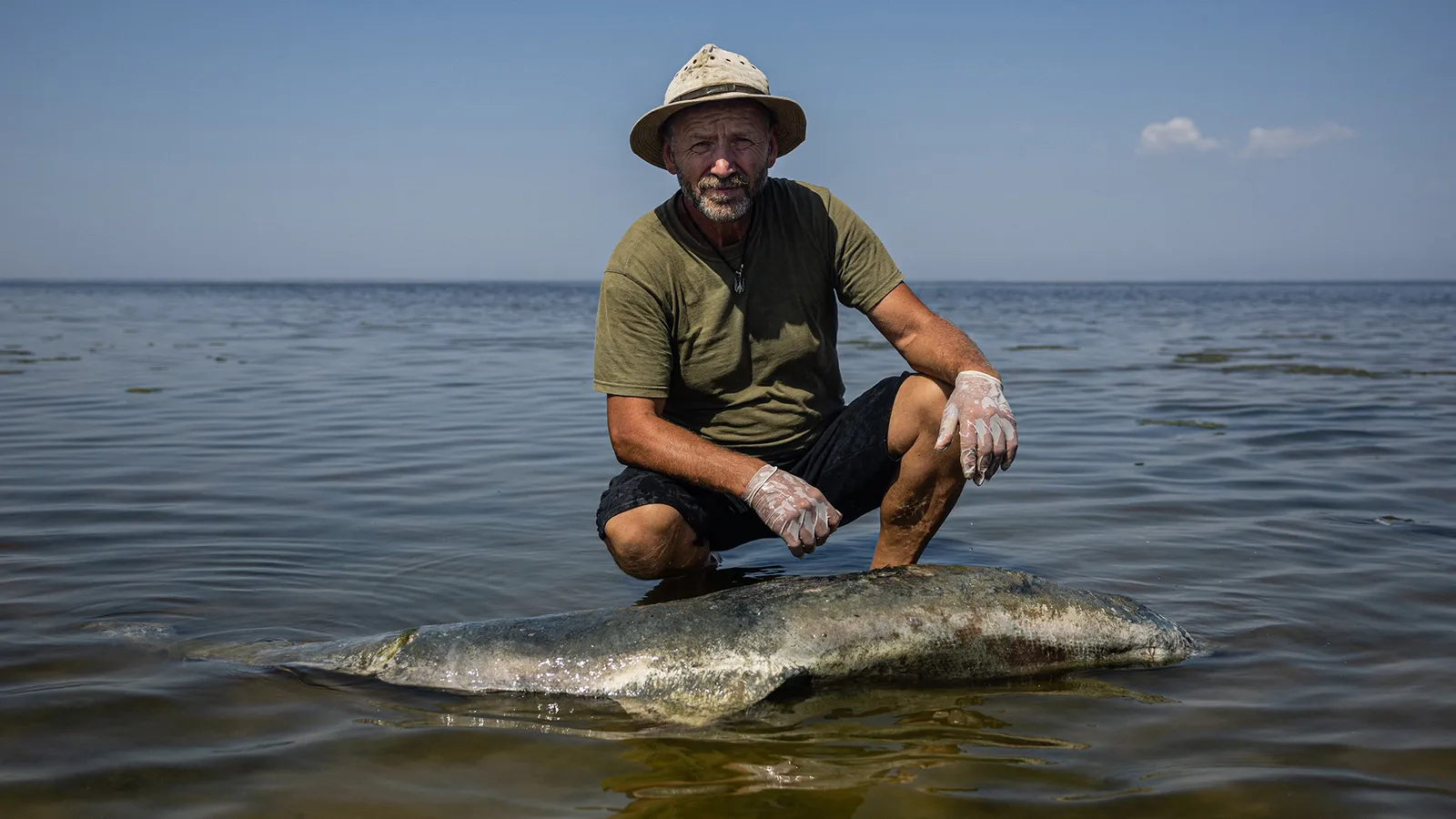How the war in Ukraine is killing marine mammals
Dolphins and porpoises have been washing up dead on the shores of the Black Sea in unusually high numbers – scientists investigating the strandings are now pointing the finger at increased Russian naval activity due to the war in Ukraine.

Every morning at dawn, Ivan Rusev walks along the shoreline of the Black Sea in south-western Ukraine. In the autumn, he was watching as millions of migratory birds set off for the south. The last of the pelicans departed at the end of September and they won't return until March.
While these migrations continue in their established patterns, other wildlife in this region have been greatly disturbed. In the months after Russia's full-scale invasion of Ukraine in February, Rusev noticed a new and troubling phenomenon: dolphins and porpoises were washing up dead on the beach in unusually high numbers. When he'd found dead animals here in previous years, many had marks on their bodies that suggested they had got caught up in fishing gear. These latest marine mammals had none.
Rusev is the head of research at Tuzly National Nature Park, in south-west Ukraine, not far from the border with Moldova. In a normal year, he says, he finds perhaps three or four dead dolphins along the 44km (27 miles) of shoreline in the park. Once the war began, most of the shoreline was closed by the military. Between 24 February 2022 and the end of August, he and his colleagues discovered 35 dead cetaceans along the 5km (3 miles) of shoreline still accessible. His team spoke to their counterparts in other Black Sea countries, except Russia and Georgia. Some of Ukraine's national parks, including one near the devastated city of Mariupol, are now in Russian occupied territory. Rusev's team couldn't reach any of their colleagues there.
When they put all the numbers together, 2,500 dead dolphins had been reported to have washed up on shore by May 2022. But because most dead dolphins simply sink to the bottom of the sea and are never counted, Rusev believes the actual number is much higher. Other organisations around the Black Sea have also noticed an increase. Mare Nostrum, a Romanian association of environmental specialists, says it has registered the highest number of stranded cetaceans since at least 2010. Marian Paiu, executive director of Mare Nostrum, says they had recorded 194 individual animals stranded between January and the end of September. In most years, they record fewer than 100.
The main culprit, Rusev argues, is acoustic trauma from the increased use of sonar by mainly Russian submarines.
"When dolphins obtain this pressure from sonar, it destroys the acoustic system fully. He [the dolphin] has no possibility to navigate himself, so he has to struggle and probably to crash... [We] just saw dolphins without any marks. When we saw dolphins before [the] war, we saw [marks] from the net on the body or cutting fins," he says.
Dolphins and porpoises use ecolocation – a biological form of sonar – to navigate and communicate, whistling, squeaking, buzzing and clicking their way through the water. There's now considerable evidence to suggest a link between the naval use of sonar and acoustic trauma in cetaceans. In 2000, after a mass stranding in the Bahamas, the US Navy determined for the first time that the cause was sonar used in exercises. Researchers found that the largest mass stranding event in the UK, in Cornwall in 2008, was probably caused by naval activity. At least 26 short-beaked common dolphins died in the incident after international naval exercises, including the use of mid-frequency sonar, had taken place nearby just four days earlier.
But military secrecy has sometimes impeded research on the problem. In a 2021 status report, Accobams (the Agreement on the Conservation of Cetaceans of the Black Sea, Mediterranean Sea and Contiguous Atlantic Area) concluded: "It is difficult to provide a clear picture of the situation concerning the use of naval sonar in the Accobams area due to the confidential nature of military operations, except than exercises involving sonar and anti-submarine warfare training continue to occur in deep-diving cetaceans habitat hotspots, occasionally with lethal consequences."
For some experts, the coincidence of dolphin strandings in the Black Sea with the Russian invasion of Ukraine is too great to ignore.
"It's very significant that mass strandings began almost immediately after the Russian attack," says Pavel Goldin, of the Schmalhausen Institute for Zoology, which is based in Kyiv. He confirms the pattern of significant mass strandings began almost immediately after the Russian attack. "We take seriously the hypothesis of acoustic trauma. We've put much effort into detecting and researching acoustic trauma."
It's one thing to suspect that acoustic trauma, whatever the cause, may be to blame for the dolphin deaths – it's quite another to prove it. Damage to the inner ear of cetaceans can only be detected in samples examined within 24 hours of death, otherwise it becomes impossible to distinguish between damage to the sensitive hairs of the inner ear and post-mortem decay. Most dolphin carcasses only wash up on shore much later, when they've already started to decay. The specimens must then be sent to laboratories in Italy or Germany for necropsy. (Read more about how scientists determine cetaceans' causes of death.)
"Usually the sonar is not directly killing them, but it is leading to damages to the inner ear, which as a result is limiting the ability of the animal to get orientated, to feed," says Dimitar Popov, project manager for the conservation of cetaceans at Green Balkans, a Bulgarian non-profit. "Usually they can either get stranded alive or just die of hunger."
However, there's another element that points to sonar's role in the strandings, Goldin says. In addition to the dead dolphins, there were at least two live strandings on the Ukrainian coast this year. After a day or so, the animals recovered and returned to sea. In some cases, research indicates it's possible for the damage caused by over-exposure to sonic trauma to be reversed. If a stranding is caused by disease or an infection, the cetacean normally dies.
When full-scale war broke out in February, the Black Sea was one of the focal points. Russia views the Black Sea and its warm-water ports as essential to its security. After the collapse of the Soviet Union in 1991, Moscow leased the Crimean port of Sevastopol – home to the Russian Black Sea Fleet – from Ukraine. Russia occupied and annexed the Crimean peninsula in 2014.
The Black Sea Fleet is far bigger than Ukraine's modest navy. The Royal United Services Institution (Rusi), a security think tank, says Russia's six Black Sea submarines "substantially outmatch the regionally deployed subsurface assets" of other navies in the region. The submarines have fired at Ukraine – an additional source of acoustic disturbance, along with helicopter motors, underwater explosions, and mines. Russia has fired hundreds of missiles from the Black Sea, and any that fell in the sea would have displaced cetaceans, Popov says. In spring, he and his colleagues recorded the highest density and abundance of cetaceans off the Bulgarian coast for six years.
"The animals… are distributed in a pattern," Popov says. "This pattern has been broken and they move further south. That's why in Bulgarian waters, there was such high density." That additional density also made it easier for diseases to spread, he adds.
On the first day of the invasion (24 February), the Russian navy moved immediately to seize Snake Island, 50km (31 miles) offshore from Tuzly National Nature Park (the defiant response from Ukrainian border guards became a meme and eventually a commemorative stamp). Ukraine sank the Moskva, a guided-missile carrier and flagship of the Black Sea Fleet, in April and retook Snake Island in June.
It's this area that Rusev wants Ukraine to designate as a protected area, a maritime national park of about 5,000sq km (1,930sq miles), where dolphins would be protected. He has submitted a proposal to the ministry of environment, which has given its backing to the idea.
In a statement, the ministry told BBC Future it was already thinking about how to restore the dolphin population and establish the Black Sea afalina (bottlenose) dolphin readaptation centre in Tuzly national park.
"Every year, the centre will be able to rehabilitate dolphins, as well as receive scientific data on the life of dolphins and ways to preserve their populations," a ministry spokesperson says. "The concept envisages establishing international cooperation, as well as changing the paradigm of attitude towards dolphins through educational activities. The centre will become a tourist location and annually (seasonally) visitors will be able to observe dolphins outside the dolphinariums."
-bbc







